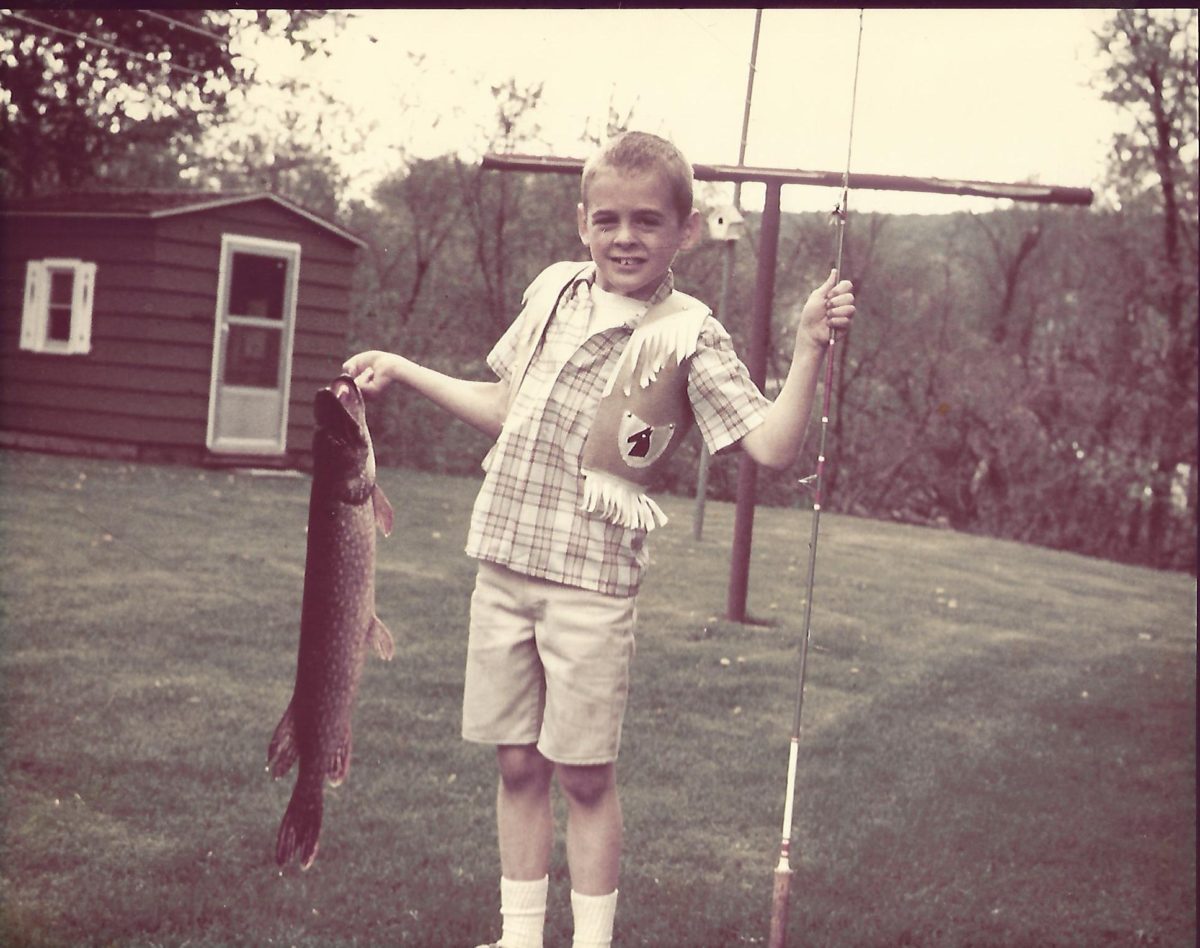The fish’s head slowly emerges, its steely, amber eyes rupture the river’s surface and glare into Ben’s eyes before it plunges, rolling back down into the dark, flashing a big yellow belly and boiling the water with its tail, waving buh-bye! Ben knows, at that moment, he has the biggest creature of his life on the end of this 6# monofilament line, spooled onto his dad’s old Shakespeare spin-cast reel the previous week. He’s glad he grabbed his dad’s rig and not his, which was a Sportmaster – Ben’s first, and one of the few reels sold at the Caroline Hardware.
Ben is nine years old, standing on a rickety, wooden dock sticking ten feet out into the Embarrass River with his sister, Judy. The water is dark and cold. He’s genuinely afraid this creature is going to pull him in.
When the fish runs, Ben holds the rod tip up and braces for whatever’s going to happen when the line comes taught. He doesn’t want to click the thumb button and release line, because he figures that would be the end of it – the fish would pull out all the line his father had just bought and loaded. Ben didn’t ask to borrow his old man’s pole.
The rod tip dips as if something is pulling it by its hair, and line zips out of the water, racing toward the fish but finding only another boil, this time deeper in the channel and heading downstream. Ben’s expecting a loud snap and quick release of tension on the rod, as it sounds when breaking off a snag. What he hears is something else: the solid, mechanical whirl of tiny steel gears as the tension drag begins to operate on the line. It’s a beautiful sound, the sound of solid engineering – not a noise the Sportsman can make. The vibration bolting through the rod handle is electric, and the tip begins to bounce as the sound of the drag diminishes and the line stops playing out.
The fish halts its run. Ben keeps tension on the line and tries to move it, just a little bit, but the fish doesn’t oblige. Ben wonders what it is. When he sees the big yellow belly his first thought is that it must be a carp, since one of the neighbors has been baiting the area with shucked field corn. But Ben was using a bass popper – a surface bait. Everyone knows carp are bottom feeders. They don’t care what’s on the surface, until it sinks.
Ben picks the popper out of his father’s tacklebox after having no luck soaking nightcrawlers under bobbers, looking for crappie and black bass (smallmouth). His dad’s rod is set up for northerns – the fishus maximus of Central Wisconsin river ponds – with a long, wire leader and a snap swivel; so changing lures doesn’t mean Ben has to tie a new knot. Which is good. Ben’s knots never look as perfect as his Pop’s.
Ben’s dad’s tackle box, like his grandfather’s, and most others he’d seen, is all metal and smells of machine oil. The top tray holds the traditional bait: Daredevil spoons striped like candy canes, streamer flies the size of small birds, barbed objects resembling mice, crayfish, leeches; and big wooden lures called plugs, handcrafted with glass eyes and dripping with treble hooks. Some are two pieces and swivel in the middle; others are designed to dive or splash along the surface when cranked. Most are painted to look like fish or frogs; but there seems to always be at least one lure sporting a thick white body and a red head – like a big toe with a bloody end – as though red and white is a color combination that provokes big northerns, the way a red cape provokes a ringed bull.
But Ben hasn’t chosen any of the big lures because he’s fishing for bass and crappie. He has caught them before and knows what to expect. The little lure he selects is just enough wood to float a hook and some hackle feathers. It’s called a popper because you “pop” the lure along the surface imitating a bug or other bait. This one is designed for bass, so it’s much smaller than the top shelf lures designed for northerns. If this is a bass he’s hooked into, it will be legend.
Ben and Judy agree it’s best to get off the dock, so they shuffle to the bank where she helps Ben get his arms around a tree while holding the pole in the direction of the fish.
“I’ll get help,” Judy says, looking at Ben, then the tree. “Just hold on!” and she’s gone. Ben looks at the rod tip as it begins to bounce again. He starts reeling in…very gently, to the quite whirl of the drag. The fish begins to move…slowly, toward him. Ben realizes, for the first time, that he might, somehow, not lose this fish. Footsteps sound behind him.
“Whatcha got, sonny?” It’s Tony Netzel, their next-door neighbor who’s out working in his yard. It’s his dock. Ben’s glad the fish hasn’t destroyed it.
“Big fish!” Ben says. “Bass!” Tony shambles out to the end of the dock just as the fish boils ten feet away. He stops and stares at the water, then looks at Ben hugging the tree.
“No,” he says. “It’s a nordern. A biggun!” Ben has never seen Tony this excited before. He’s a World War II vet and keeps to himself mostly. “I’ll git a net,” he says, looking at Ben, then the pole. “Jus hold on!” and he’s gone.
At first Ben doesn’t believe it. He isn’t old enough to go northern fishing, not even with his sister who’s a year older than him. Northerns are for grown-ups. Ben has spent plenty of time watching the old timers catch them off docks, or bring them back in rowboats. They’re frightening to look at, with that long, gator head and those rows of spike teeth. Fresh water barracuda. They’re the biggest fish in this river and are known to eat anything they can grab in their considerable jaws – including each other.
Their full name is northern pike, of course, and most people in the world simply refer to them as pike; but in central Wisconsin they’re “norderns”, second in celebrity only to their larger cousins up north – the musky. On this river, anything over 30 inches or five pounds is considered a “lunker”; fish 20-24 inches are called “jacks” or “hammer handles”; and everything in between is “not bad.”
The favored method of fishing is to set anchor from a rowboat on the pond, snag a river chub or shiner onto the biggest treble hook you have, slap a tennis ball sized bobber about three feet up from your leader, gently swing that gear out into the channel and wait for Jaws to slowly drag that indicator under, wondering if you’ll need a bigger boat.
Footsteps sound behind Ben again. Tony’s back with a landing net, almost taller than he is. “Jus hangonda im, Sonny! Bring im inda shore.” He scoots onto the dock holding the net like an infantry rifle and stabs it into the water just as the surface boils beside him. He struggles, and the water churns, but with a twist of his wrists he yells “Got im!” – and the fish is in the net. Ben will never feel the same swimming in that river. Those big teeth. His little toes.
“What are we going to do with it?” Judy asks.
“I dunno,” Ben says. He wants to get a picture with the fish, but he doesn’t want to kill it. They decide to keep it in their mom’s big metal wash tub until they had the photo taken. Judy runs ahead and gets the tub ready. Tony hustles the fish up to the garage, carrying it in the net. Ben follows with his dad’s pole, hoping he won’t get into too much trouble for borrowing it without permission
Ben’s parents don’t quite share his enthusiasm for this fish. They made it clear they weren’t interested in eating a fish with “all those y-bones” and darn sure aren’t going to clean it. So, after Ben’s grandfather comes over with his Nikon Nikkormat camera and gets the picture, and the neighbors have all left, Ben and Judy just stare at this monster in their mom’s washtub, suspended in the water, moving its head back and forth to get air. They each grab a handle of the tub and slush their way back down to the river. They walk out onto the dock and gently pour the contents of the tub into the river.
It would be nice to say that the big fish turned to look at them, and winks. But it doesn’t. It just bullwhips its body and bullet-snakes away – Jaws’ tail waving buh-bye!


